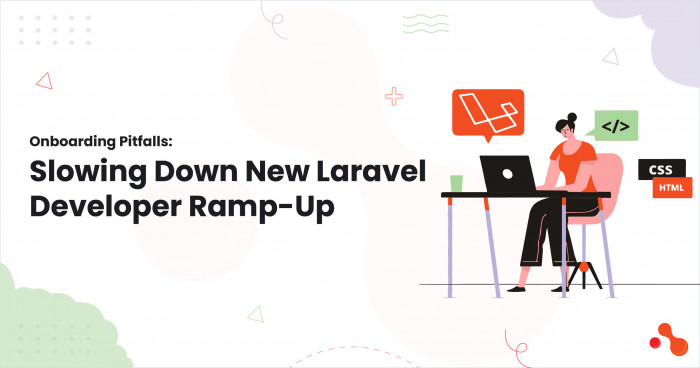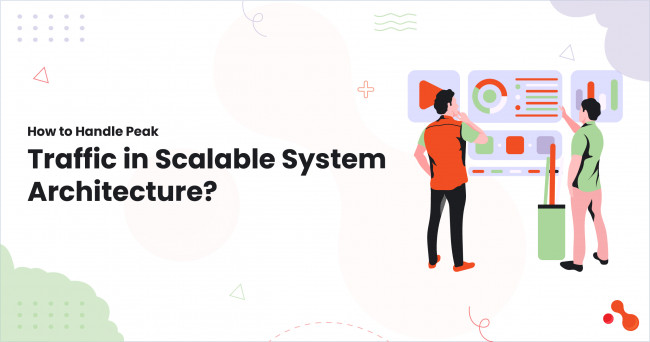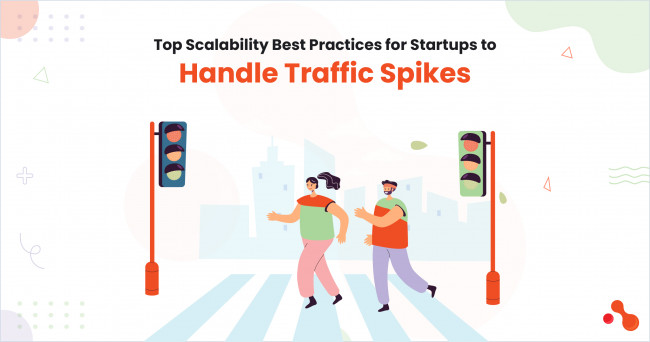Introduction

Onboarding a new Laravel developer is an essential step in ensuring your team's success and long-term productivity. Laravel is a popular PHP framework. It is known for its elegance, robustness, and developer-friendly environment, but the onboarding process for new developers can still present a range of challenges.
It is essential to understand the common Laravel developer onboarding pitfalls and take steps to avoid them. Ensure the new team members integrate quickly and contribute to the success of your Laravel projects. The onboarding process is more critical in the case where the business chooses to outsource it to a Laravel development company.
It is important to have a well-planned onboarding process, especially when you hire remote developers. This article provides more information on the common onboarding challenges slowing down new Laravel developer ramp-up.
What Is Laravel Developer Onboarding?
Laravel developer onboarding is the structured process of integrating new developers into a Laravel-based project or team. It involves familiarizing them with the project’s technical requirements, development environment, workflows, tools, and organizational culture to enable them to contribute effectively and efficiently. This process applies to in-house developers and also when you opt for a software development outsourcing company.
Common Pitfalls
Onboarding, while critical for integrating new hires, can often fall short due to various missteps. Here are some common pitfalls to watch out for when Laravel developers:
Lack of Clear Expectations and Project Overview:
When a new developer joins your team, it’s crucial that they understand the overall scope of the project, the team’s expectations, and their specific role. Too often, developers are introduced to the technical aspects of the project without a proper understanding of the project’s business goals, user requirements, or the big picture.
Pitfall: Without clarity on the project's mission and objectives, a developer may struggle to see how their work fits into the overall system, leading to a lack of motivation, poor communication, and misalignment with the team's vision.
Solution: Provide a comprehensive project overview that includes.
Project Goals: Explain the vision and goals of the project, its target audience, and its impact. Help the developer understand why the project is important.
Expectations: Be clear about your expectations for the developer’s performance, including deadlines, quality standards, and team collaboration.
Role Clarification: Clearly outline the developer’s role in the project and their specific responsibilities.
Additionally, organizing an onboarding session where senior team members explain the project and the current progress can help the new developer feel more confident and aligned.
Inadequate Setup of Development Environment:
A proper development environment setup is critical for a smooth onboarding process. Laravel projects require specific tools, dependencies, and configurations to function correctly. If new developers struggle with environment setup, it can create delays in getting started with the actual coding tasks.
Pitfall: If developers are not given clear instructions or help with setting up their local development environment, they may waste time troubleshooting errors, which could have been avoided with proper guidance.
How to Avoid It: Ensure that you provide:
Detailed Setup Instructions: Provide clear, step-by-step guides on setting up the development environment, including instructions for installing PHP, Composer, Laravel, and any other dependencies (e.g., Docker, MySQL, etc.).
Automated Setup Tools: Where possible, use tools like Laravel Homestead or Docker to standardize the development environment across all team members.
Pre-configured Development Environments: Offer a pre-configured development environment or virtual machine image (VM) to minimize setup time and avoid inconsistencies.
By providing these resources upfront, you can help new developers avoid wasting time on environment-related issues and focus on coding.
Lack of a Structured Process
Pitfall: No clear roadmap or documentation for the onboarding process, leading to confusion and delays.
Impact: New developers spend too much time figuring out workflows and systems, delaying their productivity.
Solution: Create a step-by-step onboarding plan, including setup instructions, project overviews, and expectations.
Inadequate Technical Preparation
Pitfall: Failing to provide the tools, frameworks, or access credentials necessary for work.
Impact: Delays in development environment setup and frustration for the new hire.
Solution: Prepare all resources, such as Laravel setup guides, database credentials, and required software, in advance.
Overloading with Information
Pitfall: Bombarding the new developer with excessive details and technical jargon on the first day.
Impact: The developer feels overwhelmed and struggles to retain important information.
Solution: Deliver information incrementally, starting with essentials and gradually diving into complex topics.
Insufficient Project Orientation
Pitfall: Not providing enough context about the existing codebase, project goals, or architecture.
Impact: New developers make errors due to a lack of understanding of project requirements and design.
Solution: Offer a detailed walkthrough of the project, including folder structures, workflows, and critical modules.
Ignoring Team Integration
Pitfall: Failing to introduce new hires to team members or include them in collaborative activities.
Impact: New developers feel isolated, which can affect morale and productivity.
Solution: Schedule team introductions, assign a mentor or buddy and encourage collaboration from day one.
Neglecting Training on Tools and Frameworks
Pitfall: Assuming developers are familiar with all tools, even if they’re new to Laravel or specific project setups.
Impact: Misuse of tools, inefficiency, and potential security risks.
Solution: Provide training sessions or documentation for tools like Laravel, Git, Docker, and CI/CD pipelines.
Unrealistic Expectations
Pitfall: Expecting immediate productivity without considering the learning curve.
Impact: Developers feel undue pressure, leading to errors and burnout.
Solution: Set achievable milestones and allow time for learning and adapting.
Inadequate Feedback Mechanisms
Pitfall: Not gathering feedback from the new developer about their onboarding experience.
Impact: Persistent issues remain unaddressed, and future onboarding doesn’t improve.
Solution: Conduct regular check-ins and encourage feedback to refine the Laravel developer onboarding process.
Skipping Security Training
Pitfall: Overlooking the importance of educating developers on security best practices, especially relevant for Laravel applications.
Impact: The risk of vulnerabilities like XSS, CSRF, and SQL injection increases.
Solution: Include sessions on secure coding practices, Laravel’s built-in security features, and compliance standards.
Lack of Cultural Orientation
Pitfall: Focusing solely on technical aspects while neglecting the organization’s culture and values.
Impact: The developer struggles to align with the team’s working style and ethos.
Solution: Introduce company culture, mission, and values during onboarding to create a sense of belonging.
Overwhelming Codebase with Poor Documentation: A large, complex Laravel codebase can overwhelm even an experienced developer, and for new hires, it can be particularly challenging. Without proper documentation and guidance, new developers may find it hard to navigate the application, understand the folder structure, or make contributions effectively.
Pitfall: A lack of documentation or poorly written documentation can leave developers guessing about how to use certain features, leading to inefficiency and errors in code.
How to Avoid It: Ensure your Laravel codebase has detailed documentation that covers:
Code structure and folder organization
Explanation of important functions, classes, and methods
Workflow and coding standards
API usage and integration
Readme File: The project should have a detailed README.md file with setup instructions, an overview of the system architecture, and key guidelines for contributing to the codebase.
Internal Wiki for Documentation Platform: Consider using tools like Confluence, GitHub Wiki, or Notion for storing comprehensive documentation that is easy for team members to update and refer to.
By keeping your documentation up-to-date and comprehensive, new developers will have an easier time understanding how to contribute to the project and get up to speed faster.
Lack of Proper Version Control Practices:
Version control, specifically Git, is an essential tool for collaborative development. However, improper use of version control systems can lead to conflicts, confusion, and difficulty tracking changes.
Pitfall: New developers may not be familiar with proper Git workflows, leading to issues like:
Frequent merge conflicts
Lack of proper commit messages
Unclear branching strategies
Inconsistent use of Git commands
How to Avoid It: Clear Git Workflow: Define and communicate a consistent Git workflow, such as GitFlow or feature-branching, so new developers know how to structure their commits and branches.
Commit Message Guidelines: Establish clear guidelines for writing commit messages. For instance, use conventional commit messages to maintain consistency and clarity in the Git history.
Pair Programming or Code Reviews: Pair new developers with senior team members for their initial commits or encourage code reviews to ensure adherence to version control best practices.
By promoting proper version control practices, you’ll reduce merge conflicts and improve team collaboration, making the development process smoother.
Overlooking Testing and Test-Driven Development (TDD):
Testing is an essential aspect of maintaining a high-quality Laravel application. Unfortunately, many teams don’t emphasize testing during onboarding, leading new developers to overlook this critical part of the development process.
Pitfall: Without a focus on testing, developers may write untested code that introduces bugs or fails to meet the application’s requirements. In the long term, the absence of proper testing can lead to code instability and higher technical debt.
How to Avoid It: Testing Practices: Ensure new developers are familiar with testing practices in Laravel, such as:
Writing unit tests with PHPUnit
Using Laravel’s built-in testing features (e.g., HTTP tests, database tests)
Integration testing with tools like Dusk
Encourage Test-Driven Development (TDD): Introduce TDD practices early on, where developers write tests before implementing features, helping ensure code quality and reliability.
Code Coverage: Promote the use of code coverage tools to track and ensure sufficient test coverage for all new code.
Having a solid testing culture will help prevent issues early in the development process and reduce the likelihood of bugs making it to production.
Inadequate Communication and Collaboration with the Team:
Onboarding a Laravel developer isn’t just about setting up the right environment and introducing them to the codebase. It's equally important to foster a culture of communication and collaboration. A lack of collaboration can hinder the new developer’s growth and integration into the team.
Pitfall: New developers might feel isolated or disconnected from the team, especially in remote work environments, which can lead to feelings of frustration and lack of engagement.
How to Avoid It:
Frequent Check-ins: Regularly check in with new developers to gauge their progress, address questions, and provide feedback. This can be done through daily standups or weekly one-on-one meetings.
Foster Open Communication: Create an environment where developers feel comfortable asking questions, seeking help, and sharing ideas. Tools like Slack, Zoom, and GitHub Issues can help keep communication open.
Pair Programming: Pair new developers with experienced team members to promote knowledge transfer and encourage collaboration.
By fostering strong communication and collaboration from the start, you’ll ensure that new developers feel like a part of the team and are more likely to contribute effectively.
Benefits To Outsource Laravel Requirements
Outsourcing Laravel development requirements is a strategic move that enables businesses to build robust, scalable, and secure applications efficiently. By partnering with experienced Laravel outsourcing companies, organizations can save costs, access top talent, and focus on their core objectives, all while ensuring high-quality deliverables.
Acquaint Softtech offers a wide range of Laravel development services. We have over 10 years of experience delivering top-notch solutions. To top that, we are also one of the few firms in Asia that is an official Laravel partner.
Take advantage of our extensive resources and access to dedicated professionals, including a QA team. Hire Laravel developers from Acquaint Softtech and gain the upper edge.
Cost Efficiency
Access to Skilled Talent
Faster Development Time
Focus on Core Business
Scalability and Flexibility
Access to Advanced Tools and Technology
High-Quality Development
Reduced Risk
Ongoing Support and Maintenance
Time Zone Advantage
Conclusion
Onboarding new Laravel developers comes with its unique set of challenges, but these pitfalls are avoidable with the right strategies. Clear expectations, proper environment setup, comprehensive documentation, and a strong focus on collaboration and testing will ensure that new developers hit the ground running and become productive members of the team.
By addressing the common onboarding pitfalls, you can streamline your onboarding process, reduce frustration, and build a stronger, more effective Laravel development team. Whether you're managing a small team or scaling a large Laravel project, a successful onboarding process is key to long-term success and developer satisfaction.















